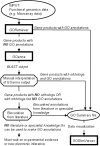AgBase: a unified resource for functional analysis in agriculture
- PMID: 17135208
- PMCID: PMC1751552
- DOI: 10.1093/nar/gkl936
AgBase: a unified resource for functional analysis in agriculture
Abstract
Analysis of functional genomics (transcriptomics and proteomics) datasets is hindered in agricultural species because agricultural genome sequences have relatively poor structural and functional annotation. To facilitate systems biology in these species we have established the curated, web-accessible, public resource 'AgBase' (www.agbase.msstate.edu). We have improved the structural annotation of agriculturally important genomes by experimentally confirming the in vivo expression of electronically predicted proteins and by proteogenomic mapping. Proteogenomic data are available from the AgBase proteogenomics link. We contribute Gene Ontology (GO) annotations and we provide a two tier system of GO annotations for users. The 'GO Consortium' gene association file contains the most rigorous GO annotations based solely on experimental data. The 'Community' gene association file contains GO annotations based on expert community knowledge (annotations based directly from author statements and submitted annotations from the community) and annotations for predicted proteins. We have developed two tools for proteomics analysis and these are freely available on request. A suite of tools for analyzing functional genomics datasets using the GO is available online at the AgBase site. We encourage and publicly acknowledge GO annotations from researchers and provide an online mechanism for agricultural researchers to submit requests for GO annotations.
Figures

References
-
- Goff S.A., Ricke D., Lan T.H., Presting G., Wang R., Dunn M., Glazebrook J., Sessions A., Oeller P., Varma H., et al. A draft sequence of the rice genome (Oryza sativa L. ssp. japonica) Science. 2002;296:92–100. - PubMed
-
- Hillier L.W., Miller W., Birney E., Warren W., Hardison R.C., Ponting C.P., Bork P., Burt D.W., Groenen M.A., Delany M.E., et al. Sequence and comparative analysis of the chicken genome provide unique perspectives on vertebrate evolution. Nature. 2004;432:695–716. - PubMed
-
- Yu J., Hu S., Wang J., Wong G.K., Li S., Liu B., Deng Y., Dai L., Zhou Y., Zhang X., et al. A draft sequence of the rice genome (Oryza sativa L. ssp. indica) Science. 2002;296:79–92. - PubMed
-
- Spencer G., Tomlin R. NIH News Advisory. 2006.
-
- Messing J., Dooner H.K. Organization and variability of the maize genome. Curr. Opin. Plant Biol. 2006;9:157–163. - PubMed

